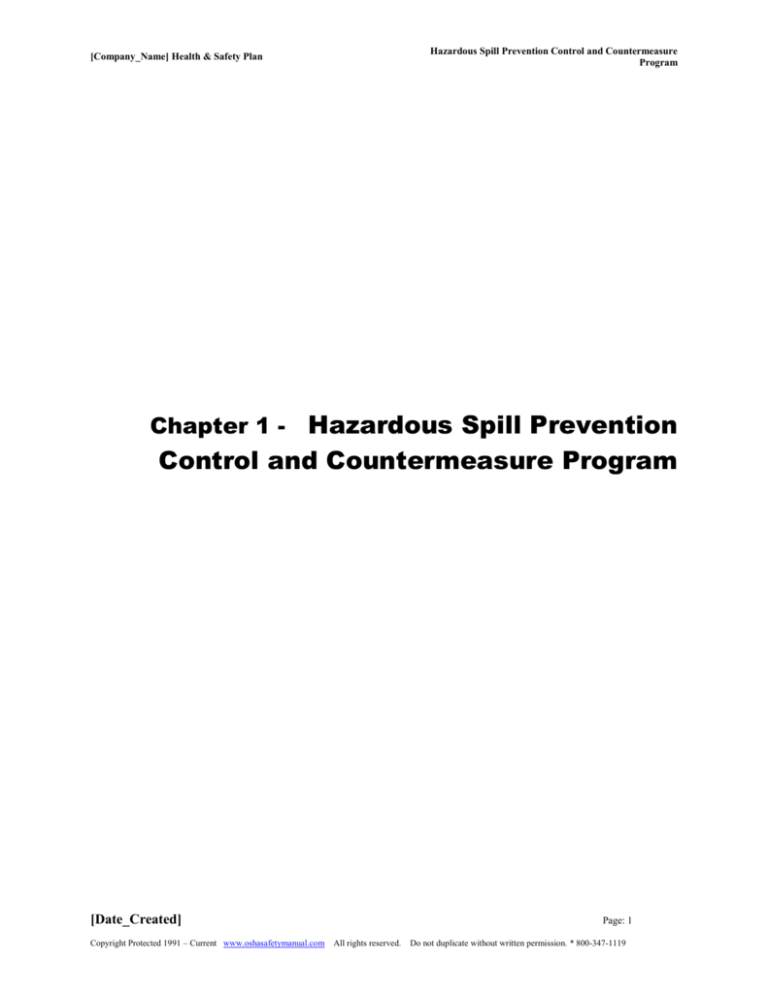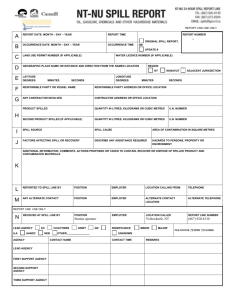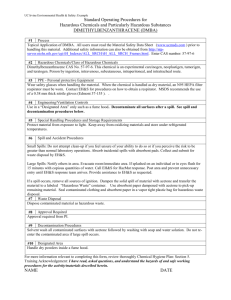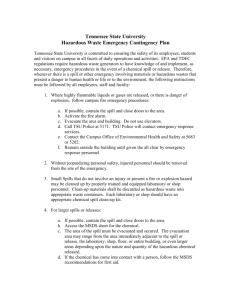
Hazardous Spill Prevention Control and Countermeasure
Program
[Company_Name] Health & Safety Plan
Chapter 1 - Hazardous Spill Prevention
Control and Countermeasure Program
[Date_Created]
Copyright Protected 1991 – Current www.oshasafetymanual.com
Page: 1
All rights reserved.
Do not duplicate without written permission. * 800-347-1119
Hazardous Spill Prevention Control and Countermeasure
Program
[Company_Name] Health & Safety Plan
1.1
Hazardous Spill Control and Spill Prevention
Control and Counter Measure Program
1.2
General Information
1.
FACILITY INFORMATION
NAME OF FACILITY: [Company_Name]
MAILING ADDRESS:
TELEPHONE NO.:
PLANT MANAGER:
OPERATIONS:
2.
OWNER INFORMATION
OWNER NAME:
MAILING ADDRESS:
TELEPHONE NO.:
3.
STORAGE CAPACITY AND TYPE OF MATERIAL STORED
Below Ground Tanks:
NONE
Above Ground Tanks:
NONE
Miscellaneous Laboratory Chemicals including:
Ethanol
- 5 gallon containers
Formic Acid - 100 gallon container.
4.
DATE OPERATION BEGAN
[Company_Name] has not begun full operations at this facility yet.
5.
SCHEMATIC DIAGRAM
See attached Exhibit A.
1.3
Past History of Spills and Possible Causes of Future Spills
1.
PAST HISTORY OF SPILLS
There have been no spills since [Company_Name] started any operations at this
facility.
[Date_Created]
Copyright Protected 1991 – Current www.oshasafetymanual.com
Page: 3
All rights reserved.
Do not duplicate without written permission. * 800-347-1119
Hazardous Spill Prevention Control and Countermeasure
Program
[Company_Name] Health & Safety Plan
2.
POSSIBLE CAUSES OF FUTURE SPILLS
No spills are anticipated. Care is taken in the storage and use of any chemicals.
1.4
Preventable Measures
The following preventative measures have been included in [Company_Name]'s spill
prevention program:
1.
TRAINING
All employees, including supervisors and any maintenance personnel, will be
advised by the management staff of procedures to be followed in case of emergency (see Section
IV). This includes possible pollution hazards, drainage and personnel to be contacted should an
emergency arise. All pertinent information is posted in the supervisor's office.
2.
SECURITY
The facility operates 8 hours per day, five days per week.
The facility is protected by a Central Station Burglar/Fire Alarm System.
3.
INSPECTIONS
An inventory is taken weekly of the quantity of material and chemical on site.
Storage cabinets are check and maintained as above.
Records of inspections are retained at the facility.
1.5
Contingency Plan
The following is a summary of the complete plan. Please refer to the 'CONTINGENCY
AND EMERGENCY PLAN" for complete details.
A.
EMERGENCY PROCEDURE
In the event of any spill, the following emergency action is to be taken:
1.
Contain any spilled material by the use of absorbent material and/or manually
pumping the spilled material into container.
2.
Contact one of the following in the order listed:
[Date_Created]
Copyright Protected 1991 – Current www.oshasafetymanual.com
Page: 4
All rights reserved.
Do not duplicate without written permission. * 800-347-1119
Hazardous Spill Prevention Control and Countermeasure
Program
[Company_Name] Health & Safety Plan
a. (Coordinator’s name)
b. (Name)
3.
(Coordinator’s name) will contact the FIRE DEPARTMENT @ 911 immediately
and assist them however possible. He will also notify the STATE OFFICE OF EMERGENCY
SERVICES (800) 852-7550 and report the following:
a.
Name and telephone number;
b.
Company name and address;
c.
Time and type of incident;
d.
Name and quantity of materials;
e.
Extent of injuries, if any; and
f.
Possible hazards to others or the environment.
g.
When the emergency situation is under control, cleanup or neutralization
can begin using appropriate tools, safety equipment, and outside services as necessary,
depending on the type of emergency. All hazardous materials must be cleaned up, stored
properly or hauled to an appropriate dump site for disposal.
h.
Before normal operations begin again, all tools, emergency equipment and
devices listed on the Emergency Equipment List must be operational and ready for use. The
(address) COUNTY ENVIRONMENTAL HEALTH DEPARTMENT must also be notified.
i.
Within 15 days after an emergency that requires implementing the
contingency plan, a written report must be completed and sent to the (address) COUNTY
ENVIRONMENTAL HEALTH DEPARTMENT and a copy will be kept for our files. See
Exhibit "B" for this report.
The report must contain the following:
a.
Owner's Name, address, and telephone number;
b.
Company name, address, and telephone number;
c.
Date, time, and type of emergency;
d.
Name and quantity of materials involved;
e.
Extent of injuries, if any;
f.
Assessment of actual or potential hazards to human health or the
environment, if applicable; and
g.
Estimated quantity and disposition of waste resulting from the
emergency situation.
B.
CLEAN-UP OF SPILL
1.
Formic Acid, etc.
All spilled liquid acid material is to be covered with absorbent material and
sufficient amounts of water until the pH of the solution becomes neutral (estimated 5 gallons of
water/container). The residue is then to be placed into a closed durable container and disposed
of at an approved landfill.
[Date_Created]
Copyright Protected 1991 – Current www.oshasafetymanual.com
Page: 5
All rights reserved.
Do not duplicate without written permission. * 800-347-1119
Hazardous Spill Prevention Control and Countermeasure
Program
[Company_Name] Health & Safety Plan
2.
Ethanol
This flammable material and any other similar liquids are to be covered with
absorbent material and spread to soak up any remaining spilled material. The contaminated
absorbent material is to be swept up and placed into a closed durable container and disposed of at
an approved landfill for off-site disposal.
3.
A "Spill Event Record" is to be completed. See attached Exhibit B.
EXHIBIT B
1.6
Spill Event Record
1.
NAME OF PERSON REPORTING
2.
ADDRESS OF PERSON REPORTING
________________________________________________________________
3.
TELEPHONE NUMBER OF PERSON REPORTING
______________________________________________
4.
EXACT LOCATION OF SPILL
________________________________________________________________
________________________________________________________________
________________________________________________________________
5.
COMPANY NAME AND LOCATION
________________________________________________________________
________________________________________________________________
________________________________________________________________
6.
MATERIAL SPILLED
________________________________________________________________
7.
ESTIMATED QUANTITY
________________________________________________________________
8.
SOURCE OF SPILL
________________________________________________________________
[Date_Created]
Copyright Protected 1991 – Current www.oshasafetymanual.com
Page: 6
All rights reserved.
Do not duplicate without written permission. * 800-347-1119
Hazardous Spill Prevention Control and Countermeasure
Program
[Company_Name] Health & Safety Plan
9.
CAUSE OF SPILL
________________________________________________________________
10.
NAME OF BODY OF WATER INVOLVED
________________________________________________________________
________________________________________________________________
11.
ACTION TAKEN FOR CONTAINMENT AND CLEAN-UP
________________________________________________________________
________________________________________________________________
EXHIBIT C
1.7
Clean-Up Procedure
1.8
General
A.
All spills, regardless of the quantity, must be contained if there is any danger of the
discharge reaching a storm drain, sanitary sewer or causing damage to the environment.
B.
After the spill has been contained, the Emergency Coordinator should be contacted to
determine if any agencies must be notified and to provide assistance with clean-up procedures.
Emergency Coordinator will need to be provided with the following information:
1. material spilled, 2. quantity spilled, 3. area where spill occurred, 4. time spill
occurred, 5. action already taken to contain or clean up spill.
C.
The following "Spill Clean-Up Procedures" for different types of spills are to be used as
guidelines. It must be remembered that any spill clean-up requires fast action and common
sense.
D.
In order to contain and clean up any spill, the facility must have certain equipment. The
following is a suggested list of materials to be available at the facility:
1.
absorbent material, Sand, etc. - 200 pounds total
2.
oil absorbent brooms, such as those manufactured by 3M
[Date_Created]
Copyright Protected 1991 – Current www.oshasafetymanual.com
Page: 7
All rights reserved.
Do not duplicate without written permission. * 800-347-1119
Hazardous Spill Prevention Control and Countermeasure
Program
[Company_Name] Health & Safety Plan
3.
air-operated diaphragm pump, complete with suction and discharge hose - 1 pump
4.
Dike material, such as Plug and Dike (available from 3WS Distributors, Inc.)
1.9
Flammable Liquid Spill
(SOLVENT)
Caution:
area.
Keep open flame, sparks or anything which might cause ignition away from spill
Procedure:
A.
Minor spill (less than 25 gallons)
1.
Turn off all equipment which might cause ignition.
2.
collect the spill.
Apply sufficient quantity of sand or noncombustible absorbent material to
3.
Open doors, windows, etc. for ventilation.
4.
Collect absorbent and place in drum/container for disposal.
Note: Even though the liquid/solvent has been absorbed, the absorbent
material may now be flammable so care should be taken not to ignite the material.
B.
Major spill (over 25 gallons)
1.
Turn off all equipment which might cause ignition.
2.
Open doors, windows, etc. for ventilation.
3.
Construct a temporary waterproof dike around the spill using oil absorbent
booms, Plug and Dike or similar material.
4.
Construct a dike around any sanitary or storm sewer drain in the area to
prevent the spilled liquid/solvent from entering the sanitary sewer or storm drain.
5.
From the diked area, the spilled material must be collected using mops,
air-operated pumps, etc., and place in drums for disposal.
6.
1.10
Collect any contaminated residue and place in drum/container for disposal.
Acid/Chemical Spill
[Date_Created]
Copyright Protected 1991 – Current www.oshasafetymanual.com
Page: 8
All rights reserved.
Do not duplicate without written permission. * 800-347-1119
Hazardous Spill Prevention Control and Countermeasure
Program
[Company_Name] Health & Safety Plan
Caution:
Do not allow spilled material to come in contact with skin or eyes.
Procedure:
A.
Caustic spill (pH greater than 7.0*): Caustic materials include:
Caustic Soda (Sodium Hydroxide)
Oil Base Sweep #20
1.
Contain the spilled material using a dike of sand or other noncombustible
absorbent material.
2.
Neutralize the spilled material with water or cover the spilled material with sand
if there is a danger of the spill causing damage to the environment.
3.
Small spills may be diluted with water and discharged through the wastewater
treatment system.
4.
Collect any contaminated residue, sand and/or absorbent and place in
drum/container for disposal.
B.
Acidic spill (pH less than 7.0*): Acidic materials include:
Formic Acid
1.
Contain the spilled material using a dike of sand or other noncombustible
absorbent material.
2.
3.
for disposal.
Neutralize the spilled material with absorbent.
Collect any contaminated soil, sand and/or absorbent material and place in drums
*If unsure of the pH, check with pH indicator.
[Date_Created]
Copyright Protected 1991 – Current www.oshasafetymanual.com
Page: 9
All rights reserved.
Do not duplicate without written permission. * 800-347-1119









